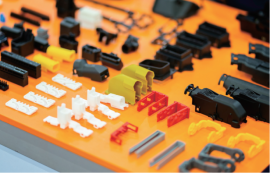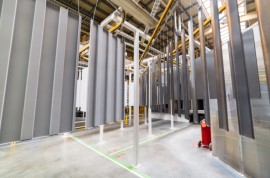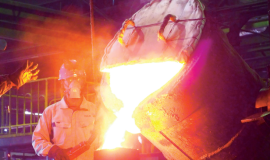In the process of electrification, the transition from gasoline-powered two-wheeled vehicles, including motorcycles and motorbikes, to vehicles that utilize "green" energy such as electric motorcycles is essential. In Vietnam, the fourth-largest motorcycle market in the world, this transition carries numerous advantages but also presents significant difficulties and challenges.

The decline of gasoline-powered motorcycles
In the 1970s, motorcycles were considered as one of the most luxurious goods in Vietnamese society. The value of a Honda Super Cub at that time was measured in "gold bars" or equivalent to several plots of land. For many years after that, owning a motorcycle such as Honda Nova Dash, Honda NSR, Yamaha Yss, Suzuki RGV 120, Simson S51, etc. remained pride for well-off urban people.
It was not until 2002 when the first Honda Wave Alpha appeared in the market that a true revolution took place, changing the landscape of the motorcycle market in Vietnam. With a listed price of only 10,990,000 Vietnamese dong, equivalent to a year's salary of civil servants and officials, the Wave Alpha quickly became a "national" model and gradually appeared in households. Other models from Suzuki, Yamaha, VMEP, Lifan also saw significant increases in sales over the years. The high-end motorcycle market shifted towards imported motorbikes such as the Honda Spacy, Piaggio Liberty, VMEP Atilla, etc.
Since 2010, the motorcycle market has become more clearly stratified and entered the "golden age" of motorcycles in Vietnam. The majority of households, both in urban and rural areas, own at least one motorcycle. It could be an entry-level model priced below 15 million dong, targeting low-income workers and students, or a domestically produced scooter with a relatively affordable price ranging from 40 to 90 million dong. In the premium segment, imported fully-assembled motor scooters and some large-displacement motorcycles from the United States, the United Kingdom, and Japan are still prioritized. Motorcycles have truly become the common means of transportation for Vietnamese people, and the market is gradually transitioning towards motorization.
In 2018, the Vietnamese motorcycle market achieved a record sales volume of over 3.3 million units, the highest in history, with a growth rate of 3.5%. This figure only includes the sales of five motorcycle manufacturers in Vietnam: Honda Vietnam, Piaggio Vietnam, Suzuki Vietnam, SYM Vietnam, and Yamaha Motor Vietnam, excluding large displacement motorcycles and imports. On average, Vietnamese people bought about 9,000 motorcycles of various types every day. At that time, many experts believed that the Vietnamese motorcycle market had reached saturation and would be difficult to grow in the following years.
This prediction was proven during the three years of the global Covid-19 pandemic. Motorcycle growth began to stagnate, with sales reaching 3.25 million motorcycles in 2019, over 2.7 million motorcycles in 2020, and 2.49 million motorcycles in 2021. In 2022, despite the gradual control and containment of the disease, and an increase in consumer demand, motorcycle sales only reached 3 million motorcycles. In the first six months of 2023, motorcycle sales of VAMM members reached 1,223,614 units, a 13.1% decrease compared to the same period. Typically, the motorcycle market experiences strong growth in the third quarter, especially before the start of the new school year, targeting primarily students. However, with the significant decline in the first six months, it is very difficult for the motorcycle market to achieve the growth rate seen in 2018.
From the perspective of manufacturers, during the 2010-2023 period, the Vietnamese motorcycle market was almost exclusively dominated by five major businesses, including three representatives from Japan: Honda (occupying 81% market share), Yamaha, and Suzuki. Many opinions suggest that consumers nowadays no longer view motorcycles as a symbol of status and only as a means of transportation. The new motorcycle models introduced each year have not seen significant changes. It is time for the domestic motorcycle market to undergo a change in quality, similar to what happened over 20 years ago.
The Era of Electric Motorcycles
Similar to an evolutionary process, the traditional gasoline-powered motorcycle market, when reaching saturation, will undergo a transformation in quality and enter a declining phase. However, the demand for transportation continues to increase along with the rapid population growth. This presents an opportunity for new, modern, and environmentally friendly modes of transportation to emerge as trends of the era. Among them, electric motorcycles are identified as a promising candidate for this trend.
In fact, electric motorcycles began to appear and gain popularity in some urban areas of Vietnam from around 2005-2006, starting with electric bicycles. Subsequently, electric motorcycle models from China also entered the market, imitating the famous motor scooter designs. With a relatively cheap price, high speed, and being more convenient than regular bicycles, electric motorcycles quickly attracted a significant number of customers, including students and housewives. However, due to a lack of clear direction, the electric motorcycle market in Vietnam soon revealed fatal weaknesses.
Firstly, before 2010, major motorcycle manufacturers focused on developing new models and expanding their market shares in Vietnam, without actively participating in the development of electric motorcycles. The electric motorcycle market mainly concentrated on brands from China or domestically-assembled motorcycles with 100% imported components (CKD). Generally, many low-quality electric bicycles and motorcycles from China in the Vietnamese market experienced issues such as short battery life and rapid deterioration of the vehicle structure after only a few years of use.
Secondly, the majority of customers purchase electric motorcycles as a secondary means of transportation, with only a very small number buying them to replace their gasoline-powered motorcycles. With the mentality of it being an auxiliary vehicle, users tend to choose cheaper electric motorcycles to save costs. Additionally, when the time comes to replace components, many people decide to buy cheap batteries or chargers of unknown origin, which can lead to dangerous consequences such as fires and explosions, causing harm to people and property.
Therefore, the Vietnamese electric motorcycle market needs to converge three factors, which are "favorable timing, favorable condition, and favorable market", to develop. This did not happen in 2006, but since VinFast ventured into the electric motorcycle segment, the market has witnessed a considerable shift.
At the end of 2018, the first electric motorcycle developed and produced by Vietnamese people was introduced, named VinFast Klara. As a domestic product, collaborating with renowned component suppliers such as Bosch, Nissin, IRC, LG, Klara has contributed to changing preconceptions about the quality and safety of electric motorcycles.
Experts believe that with current technology, it is very difficult for manufacturers to create an electric motorcycle that meets quality, technology, and safety standards at a price below 20 million Vietnamese dong while still making a profit. Therefore, VinFast's participation has contributed to pushing rival companies to develop high-quality electric motorcycle models to supply the market.
Accordingly, Yadea has introduced new models such as S3, S3 Pro, G5 (priced from 20-30 million Vietnamese dong); Pega offers products like Go-S and XMEN+ at a fixed price of 25 million Vietnamese dong; Dibao introduces SQ2, Pansy S3, Pansy S4, and GoGo S5 with prices below 21 million Vietnamese dong.
According to statistics from the International Council on Clean Transportation (ICCT) in 2020, VinFast quickly dominated the electric motorcycle market with a market share of 43.4%, followed by Pega at 15.7%, Dibao at 11.8%, Yadea at 8.6%, and Anbico at 8.3%, etc.
As a product closely associated with the development of science and technology, motorcycle manufacturers entering this market always strive to integrate the latest technologies into their products.
Most mid-range and high-end electric motorcycle models possess technologies commonly seen in cars, such as smart LED displays, full-LED lighting, GPS navigation, smart keys, tire pressure sensors, ABS brakes, and water resistance capabilities. Yadea owns the Technology Far True Far (TTFAR), which allows the recovery of kinetic energy generated during movement to recharge the battery for reuse, meaning it can "charge while riding." VinFast integrates the new LFP battery technology, enabling the Evo200 model to travel a maximum distance of up to 203km on a single charge, the highest in its segment. Additionally, as a "made in Vietnam" electric motorcycle manufacturer, VinFast is the only company in Southeast Asia to possess core battery cell technology, providing a significant competitive advantage in the market.
The current market landscape is different from 17 years ago. Vietnamese businesses are increasing their investments to gain market share. Quality, design, and variety of models are continuously improved to meet customer preferences. Each motorcycle manufacturer recognizes the potential of the Vietnamese electric motorcycle market and develops its own strategies to maximize their company's strengths and advantages.
The trend of developing electric motorcycle transportation services
In some Asian countries such as China, Singapore, Thailand, Indonesia, many domestic businesses have started to completely switch to electric motorcycles to serve the daily commuting needs of employees and provide transportation services. Developing electric motorcycle ride-hailing and delivery services not only brings stable and long-term revenue for motorcycle manufacturers but also allows individual users to experience electric motorcycles, forming "green" traffic habits.
In Vietnam, in September 2022, VinFast Trading and Services Company Limited and Ahamove Joint Stock Company introduced AhaFast - the first electric motorcycle-based goods transportation service in Vietnam. At the end of November 2022, Selex Motors launched the Selex Camel electric motorcycle model, introduced as "the first electric pickup truck model in Southeast Asia." The company has partnered with Lazada Vietnam. However, it was not until Green SM Taxi, a subsidiary of GSM Green and Smart Mobility Joint Stock Company, was established in early March 2023 that the market truly took off. As an electric motorcycle startup in Vietnam, Dat Bike aims to dominate the market in this field. Specifically, in May 2023, the company signed a cooperation agreement with Gojek to pilot the use of electric motorcycles to serve users' transportation, delivery, and food delivery needs in Vietnam. The use of the Dat Bike Weaver++ electric motorcycle is advertised to help drivers reduce fuel costs by over 4 times compared to gasoline-powered motorcycles and contribute to environmental protection. On August 9, 2023, Dat Bike further reached a cooperation agreement with Baemin to operate a food delivery service, focusing on the Ho Chi Minh City market. Prior to that, after a trial period, GSM announced the official launch of the Green SM Bike service in Hanoi starting from August 14, 2023. The vehicle used is the VinFast Feliz S model, currently priced at 50 million Vietnamese dong per unit. Drivers will be able to earn up to 18 million Vietnamese dong per month.
Many challenges remain
The first and most important challenge currently is the lack of appropriate support policies to encourage domestic enterprises in developing electric motorcycles. For gasoline-powered motorcycles, businesses benefit from policies such as reducing import tax on components (according to ATIGA), supporting value-added tax (VAT) and registration fees, and supporting industry development.
In contrast, for electric motorcycles, the most notable support policy currently is a 12% reduction in the special consumption tax (SCT), registration fee exemptions, but these only apply to "pure" electric cars and not electric motorcycles.
Many opinions suggest that the government needs to take early and decisive action; specific timelines need to be established, accompanied by supportive policies that prioritize electric motorcycles and reduce support for gasoline-powered motorcycles. For example, incentives such as tax and fee advantages should be provided for enterprises involved in manufacturing and assembling electric motorcycles, developing electric vehicle batteries, establishing electric charging stations, and offering preferential electricity prices for charging. Additionally, it is necessary to designate priority areas for electric motorcycles, such as exempting or reducing parking fees and prioritizing parking spaces.
For consumers, there is a need for policies that support the transition to electric motorcycles. According to the Ho Chi Minh City Department of Transport, the implementation of the conversion from conventional vehicles to green, zero-emission vehicles is one of the provisions of Resolution 982023/QH15 on piloting certain mechanisms and policies for the specific development of Ho Chi Minh City. The city is currently developing a plan to control vehicle emissions, which includes support for citizens to switch from gasoline motorcycles to electric motorcycles. The plan is expected to be completed in September, issued in the fourth quarter of 2023, and implemented in the first quarter of 2024.
The second challenge lies in the internal factors of businesses. Currently, apart from large corporations that have started to adopt a roadmap for transitioning to "green" vehicles, the majority of other companies still maintain their development strategies for gasoline-powered vehicles to preserve profitability. According to statistics from the Traffic Police Department, as of the end of 2022, there were nearly 2 million registered electric motorcycles in the country, accounting for 2.7% of the total number of motorcycles in circulation nationwide. The consumption of electric motorcycles in 2022 increased by approximately 30-35% compared to 2021, but it still represents a very small proportion of the overall market. This figure somewhat indicates that the majority of vehicle manufacturers are still focusing on sales of gasoline-powered motorcycles.
Especially for the "major players" who dominate the majority of the motorcycle market share, they have established a strong presence and development in Vietnam for decades. The significant advantage of traditional motorcycle manufacturers and assemblers is their high localization rate, which has reached over 95%. Investing capital or even completely transitioning to the development of electric motorcycles can be a risky gamble. The costs for the development, production, and marketing teams would increase significantly, reducing competitiveness in the market. Another option is to maintain the production of gasoline-powered motorcycles while gradually transitioning to electric motorcycles. However, this also poses challenges in terms of investment costs, requiring companies to have substantial capital and be willing to take risks.
The third challenge is the difficulty of changing users' perceptions and habits. Although the trend of using electric vehicles is gradually becoming popular, it is still primarily based on research figures. Many people express agreement with the strategy of transitioning to environmentally friendly vehicles, but it has not yet turned into specific actions. The main reason is that the cost of electric motorcycles is still high compared to the income level of the majority of the population. Many people rely on gasoline-powered motorcycles as their primary means of transportation, which is essential for their families' livelihood. Therefore, they require motorcycles that can travel quickly, cover long distances, and have convenient and simple refueling options. If these conditions are applied to electric motorcycles, only a few products meet these requirements, and their prices are often high, equivalent to the value of a motor scooter on the market (excluding the cost of the battery). Additionally, charging an electric motorcycle takes a considerable amount of time, typically 8-10 hours for regular charging and 4-6 hours for fast charging, while filling up a petrol tank only takes a few minutes.
In fact, motorcycles are a relatively sensitive category. When the Government wants to implement significant policy adjustments or changes, it often faces resistance. Previous policies and regulations such as fines for unregistered motorcycles, dividing motorcycle lanes with physical barriers, dealing with old and dilapidated motorcycles, implementing environmental protection fees for motorcycles, proposing inner-city motorcycle fees, etc., have encountered negative reactions from the public and communities, making their implementation challenging in practice.
Indeed, in order to persuade users to give up the convenience of combustion engine motorcycles, there is a need for policies that prioritize electric motorcycles while increasing pressure on gasoline-powered vehicles. At the same time, a clear roadmap should be established, accompanied by gradual and subtle changes to gradually gain public consensus.
It is evident that the trend of transitioning to electric motorcycles in Vietnam is inevitable, but the development reality will always be accompanied by timing and challenges. Pioneering businesses in this field will undoubtedly have a significant competitive advantage when the market enters the "boom" phase. As more electric motorcycle models appear on the market, it will contribute to improving the quality and reducing the cost of products, benefiting consumers. If timely and attractive support policies are injected into the market, it will certainly bring about a qualitative change for the electric motorcycle market in Vietnam in the coming years.




















